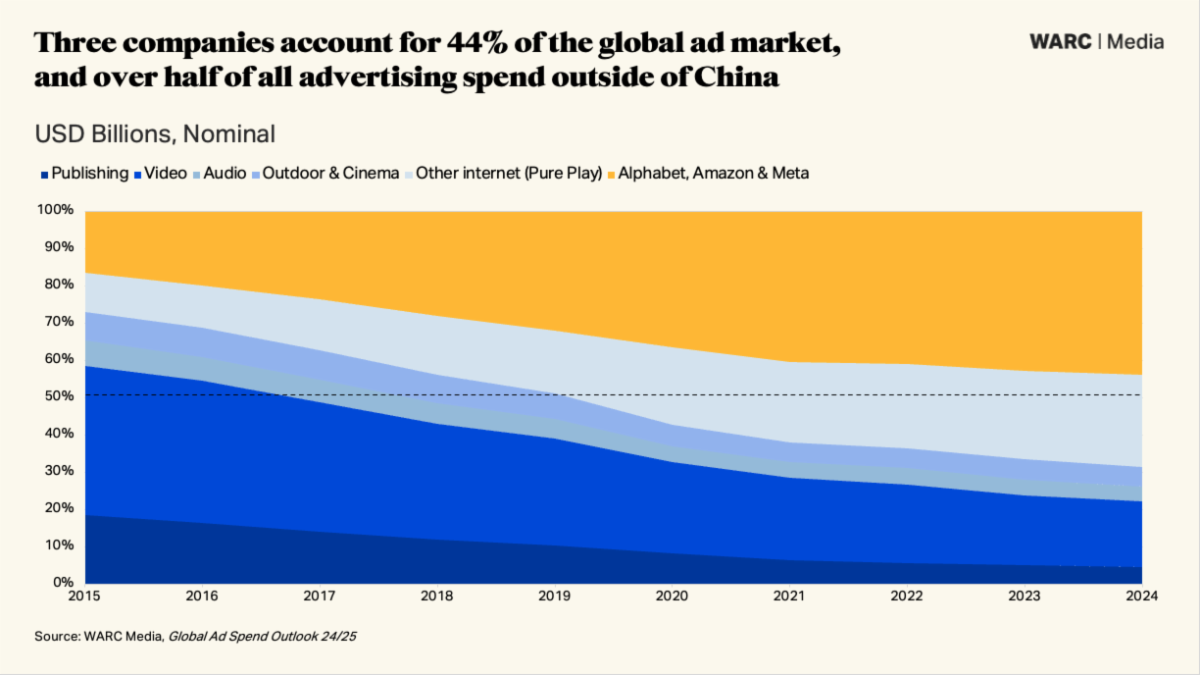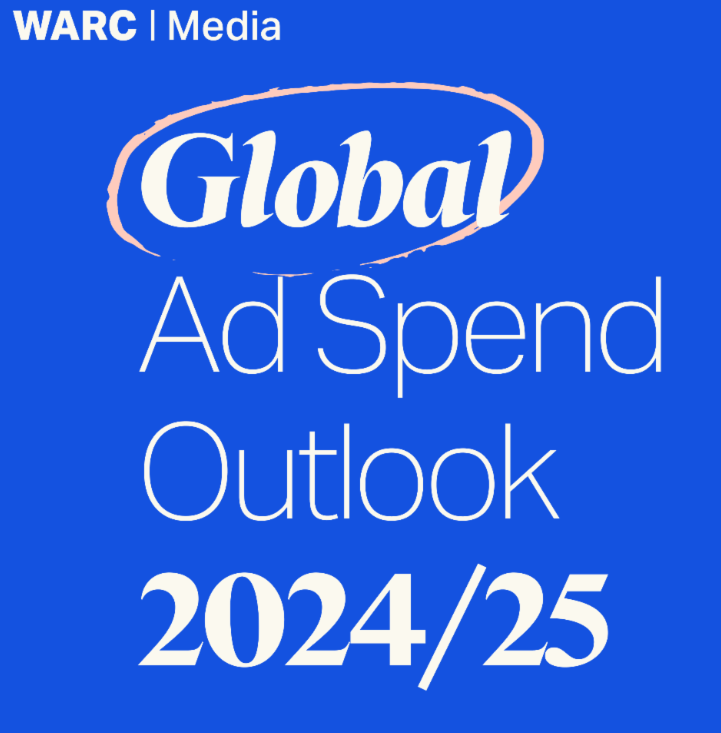Projected 10.5% rise in global spend this year represents a 2.3 percentage point (pp) upgrade to WARC forecast, reflecting the uptake of AI-enabled media tools
North America to grow 8.6% this year to $348bn, APAC market worth $272bn but growth cools to just 2.0%, Europe forecast to rise 5.0% to $165bn, Latin America +6.2% to $32.1bn, Middle East largely unaffected by looming threat of regional conflict +4.2% to $12.6bn
US political spend set to reach $15.8bn this year; $3.6bn spent across social platforms with growth rapidly increasing since change of Democratic candidate
WARC Global Ad Spend Outlook 2024/25 – A Decade of Consolidation
A new study from WARC, the experts in marketing effectiveness, has found that global advertising spend is on course to grow 10.5% this year to a total of $1.07trn – the best performance in six years if the post-Covid recovery of 2021 (+27.9% year-on-year) is disregarded.
Ad spend growth is also anticipated next year (+7.2%) and in 2026 (+7.0%), culminating in a global ad market worth $1.23trn. Global ad investment has more than doubled over the last decade, and has grown 2.8x faster than global economic output since 2014. Just three companies – Meta, Amazon and Alphabet – account for more than 70% of this incremental spend. This trifecta is expected to attract 43.6% of all advertising spend this year, rising to a share over 46% by 2026.
WARC’s latest global projections are based on data aggregated from 100 markets. New for this edition, WARC is now leveraging an advanced neural network machine learning model which projects advertising investment patterns based on over two million data points spanning macroeconomic data, media owner revenue, marketing expenses from the world’s largest advertisers, media consumption trends and media cost inflation. It is believed to be one of the most comprehensive advertising market models available to the industry today.
The new projections show that ‘pureplay’ (i.e. online only) internet companies are set to record a 14.0% rise in advertising revenue this year, reaching a total of $735.7bn. In total, almost nine in every ten (88.5%) incremental dollars spent on advertising this year will go to online-only businesses, with half (52.9%) being paid to Alphabet, Amazon and Meta. Taken together, pureplay platforms are set to account for over 70% of all advertising spend worldwide next year.
Retail media (+21.3%), social media (+14.2%) and search (+12.1%) are set to lead digital growth in 2024, with these three sectors alone accounting for over 85% of online spend and almost three in every five (58.7%) incremental dollars spent on advertising worldwide this year. All are benefiting from the increased adoption of AI-driven ad services and growing appreciation of first party data.
James McDonald, Director of Data, Intelligence and Forecasting, WARC, and author of the research says: “The global ad market has doubled in size over the last decade, with advertising investment growing almost three times faster than economic output since 2014. Three companies – Alphabet, Amazon and Meta – have been the largest beneficiaries from this period of expansion, attracting seven in ten incremental ad dollars over the last ten years.
“With retail media expected to lead ad spend growth over the coming years, and with new, diverse players emerging in ad selling – from Uber to Chase – we are once again seeing the value of first party data in targeting the right person with the right message at the right time. Such data, combined with new AI enhancements, will constitute the fabric of the advertising industry for the next decade and beyond.”

Key findings outlined in WARC’s Global Ad Spend Outlook 2024/25 are:
MEDIA TRENDS: Global ad spend is forecast to rise 10.5% this year to a total of $1.07trn, and then 7.2% in 2025 and 7.0% in 2026; social, retail media and CTV to lead growth
At $241.8bn in 2024, social media is the largest single advertising channel measured in WARC’s study, having overtaken search (excl. retail media) for the first time last year. It accounts for 22.6% of all global ad spend this year and is forecast to rise to a share of 23.6% by the end of 2026.
Within social, Meta is the largest individual player, commanding 62.6% of the market this year. Its share is being eroded however, most notably by Douyin and TikTok owner Bytedance, which now draws a fifth (20.1%) of all social spend, up from a share of just 9.3% five years ago. TikTok is on course to account for over half of its parent-company’s advertising revenue for the first time next year with estimated ad billings over $28bn, though uncertainty remains around the platform’s future in the US – its largest market by far with 170m monthly active users.
The main social platforms have reported a fillip from new, AI-enabled services during the first half of 2024, a trend that is set to underpin the advertising industry at large over the coming years. Over half of all AI-enabled spend – defined as involving some form of recommendation algorithm, natural language processing or search optimisation – today occurs in the social media sector.
Search advertising (excluding retail media) accounts for 21.8% of global advertising spend, at a forecast total of $223.8bn this year. Its share has consistently grown since WARC began monitoring the sector in 2013, though it is set to plateau in 2026 as more purchase journeys begin in retail media environments and social commerce begins to realise its potential outside of Asia. Another potential headwind may be the rise of AI-driven search, and uncertainty around what the ad experience will look like for consumers more familiar with text-based search experiences.
Google accounts for more than four-fifths (84.0%) of the global search market, with its paid search revenue set to top $200bn for the first time next year. Google’s share rises to over 90% if China is excluded, a position of dominance which this month led a US judge to rule the company in breach of antitrust laws.
Retail media is expected to account for 14.3% of global ad spend this year – a total of $152.6bn – which is double the share recorded in 2019 before the pandemic contributed to an exceptional growth spurt. Indeed, retail media is expected to be the fastest-growing channel over at least the next three years.
Amazon is the dominant global player, with anticipated ad revenue (excluding Twitch and Prime Video) of $55.9bn equivalent to more than a third (36.6%) of all retail media spend and over two-thirds excluding China this year. While competition is heating up, such billings eclipse the near $4bn Walmart is due to net in 2024 and the $1bn ad business Uber is building, while Amazon is also due to have surpassed Alibaba by ad revenue for the first time this year.
CTV is on course to be worth $35.3bn to advertisers this year, roughly a quarter of the size of the linear TV market. Growth is rapid; CTV spend is expected to rise 19.6% and is set to account for two-thirds of all growth in the video (linear + CTV) market this year, and all growth in 2025. By 2026, CTV is projected to account for almost a quarter (23.9%) of all video ad spend, at $46.3bn.
Netflix is the largest streaming provider globally, with 277.6m subscribers worldwide in Q2 2024. However, its global advertising business is unlikely to grow too far beyond $1bn this year. YouTube’s ad income – which we do not yet classify as CTV – is expected to rise 14.3% to $36.0bn this year. Further, YouTube’s ad revenue is set to top $45bn globally by 2026, almost as much as the entirety of the global CTV industry at that time.
Legacy media, encompassing print publishing, broadcast radio, linear TV, cinema and out of home (OOH), now collectively account for a quarter (25.3%) of total advertising spend, having recorded a dip in share in each of the last 15 years.
Advertising spend on legacy media is expected to total $270.5bn this year, representing a 1.5% rise from 2023. Much of this growth can be attributed to US political spending; with this removed legacy media are, collectively, set to record a 0.5% decline in advertiser investment in 2024.
Linear TV spend is expected to grow by 1.9% this year, its best performance since 2014 if the post-Covid recovery year of 2021 (+12.7%) were excluded. The market is flat (+0.1%), however, excluding US political spend. Out of home (+7.2%) and cinema (+6.1%) will see some growth this year, though radio (-2.3%) is expected to record its third consecutive year of decline.

